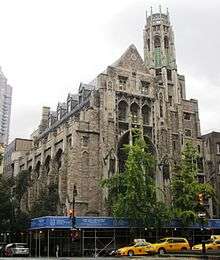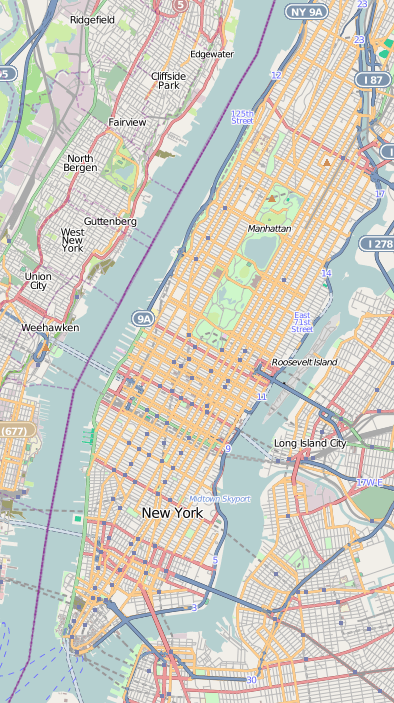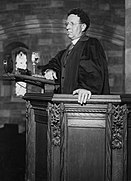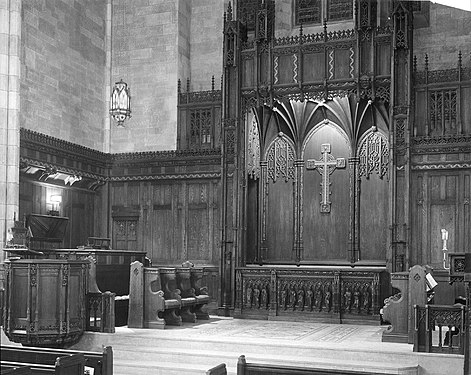Central Presbyterian Church (New York City)
Central Presbyterian Church is a historic congregation on the Upper East Side of Manhattan in New York City,[4] founded by pastor and abolitionist William Patton in 1821. It is a member of the Evangelical Presbyterian Church,[5] and it worships in a Gothic Revival structure completed in 1922 that was originally commissioned and largely funded by John D. Rockefeller, Jr. as Park Avenue Baptist Church.
| Central Presbyterian Church | |
|---|---|
| Central Presbyterian Church of New York City | |
 | |
 Central Presbyterian Church | |
| 40°45′56.5″N 73°58′01.9″W | |
| Location | 593 Park Avenue New York, New York |
| Country | United States |
| Denomination | Evangelical Presbyterian Church (United States) |
| Membership | 270 |
| Weekly attendance | 500 |
| Website | centralchurchnyc.org |
| History | |
| Former name(s) | Park Avenue Baptist Church |
| Founded | 8 January 1821 |
| Founder(s) | William Patton[1] |
| Events | First service in current building, September 22, 1929 |
| Associated people | John D. Rockefeller, Jr., Harry Emerson Fosdick |
| Architecture | |
| Architect(s) | Henry C. Pelton[2], Allen & Collens[3] |
| Style | neo-Gothic |
| Completed | 1922 as Park Avenue Baptist Church |
| Specifications | |
| Capacity | 700 |
| Clergy | |
| Senior pastor(s) | Jason Harris |
| Pastor(s) | Ed Sirya |
_Logo.png) | |
Today, Central is a culturally diverse body of more than 500 people, including seasoned leaders, many families, and a dynamic body of students, young professionals, and artists. The church currently hosts three Sunday services and as well as lectures, seminars, and chamber music concerts.[6][7][8]
History
.jpg)
Origin
In March 1820, the church that would eventually become Central Presbyterian Church was a small church plant started by William Patton. The church held gatherings in a schoolroom on Mulberry Street at Patton's expense. In January 1821, the church was officially founded by Patton. He was only 22 years old at the time of the establishment of the church. In February 1821, the church was incorporated as a religious corporation in the state of New York.[9][10]
Growth
In the Central's first year, the congregation grew considerably and acquired their first church building, on the north side of Broome Street. The building opened for weekly services in May 1822 with Patton distinguished as Central's first pastor. Despite such humble beginnings, the church quickly become influential in both New York City and the world. William Patton was very involved in many different engagements during his time as pastor, such as founding Union Theological Seminary and publishing acclaimed articles, including those arguing against slavery as a staunch abolitionist.[11] Patton was succeeded by Rev. Dr. William Adams, a pastor known for his forceability and eloquence. The church grew rapidly during Adams' pastoral leadership; however, Central's Broome Street location had found itself in a vicinity that had become over-saturated with businesses.[12]
In 1869, a site was purchased for the congregation on 57th Street between Broadway and Seventh Avenue, and when Fifth Avenue Presbyterian Church decided to move from Fifth Avenue and 19th Street to its present location on 55th Street, they donated their 19th Street edifice to Central Church. Moved brick by brick and pew by pew to its new location, the old Fifth Avenue structure became Central's new home.[13]
During the pastorate of the Rev. Dr. Milton Merle-Smith, Central opened missions in Hyden, Kentucky in 1894 and Huaiyuan County, Anhui Province, China in 1901.[14] Charles Ives was the organist from 1900-1902.[15][16] In December 1904, The Big Brothers of New York, Inc. found its starts at a men's club at Central Presbyterian Church.[17]
In 1915, Madison Avenue Reformed Church (on the northeast corner of Madison Avenue and 57th Street) bought Central Church (the old Fifth Avenue edifice), and in exchange, Central bought the Madison Avenue structure, which was closer to where many of its members were then living on the Upper East Side.[18] [19] A long and distinguished pastorate of 31 years in the person of the Rev. Dr. Wilton Merle-Smith ended with his retirement in 1920 and his death on October 3, 1923, concluding a significant era in the church's history.

In 1926, Central purchased the Park Avenue Baptist building as Harry Emerson Fosdick's liberalist preaching was drawing such large crowds that the Park Avenue Baptist congregation needed to move to a larger space, which prompted the construction of Riverside Church. In the interim before Riverside finished construction, Central met at the Plaza Hotel and, after closing on the purchase, held its first service in its new home at 593 Park Avenue on Sunday, September 22, 1929, shortly before the October 1929 stock market crash.[20]
Musica Sacra (New York City) was founded in 1964 at Central under the music directorship of Richard Westenburg. In the 1970s, the church was facing budgetary problems and declining membership and was sold to the Asia Society in 1975 to be demolished for a new building to house a $10‐million collection of Asian art given to the institution by John D. Rockefeller III.[21] However, the transaction did not go forward due to a court proceeding initiated by certain members of Central.[22]
Renewal
After a period of drastic decline in the church, dynamic renewal began to take place in 2006. A group of dedicated Christians from around the greater New York City area began attending Central in an attempt to revitalize the church. The Rev. Dr. J. Howard Edington was called as "Preacher in Residence" of Central Presbyterian Church in 2008, and the Rev. Dr. Douglas Webster was called as pastor in 2010, stabilizing and repositioning the church for the future. As an extension of the revitalization effort, the Rev. Jason Harris joined Central as Director of Church Renewal through a partnership with the New City Commons foundation in August 2011, under whose leadership the church entered a period of significant growth and renewal. In June 2013, Central joined and affiliated with the EPC. The congregation also called Harris to serve as the Senior Pastor, and he was installed to the position on April 27, 2014.[23] In June 2017, the Rev. Ed Sirya was called to serve as Assistant Pastor of the church. Dr. Seth Ward has served as Worship director since January 2009.[24]
In 2018, Central launched the public phase of its campaign to restore the facade of the building, having retained Walter B. Melvin Architects since 2011 to create a plan for the restoration and renewal of the building.[25]
Locations
In response to rapid demographic changes in New York City, Central Presbyterian Church moved a number of times to different brick and mortar locations.
- Broome Street (1821-1866)
- 7th Avenue (1876-1915)
- Madison Avenue (1915-1927)
- Park Avenue (1929-Present)[26]
Architecture
Central's current building was originally Park Avenue Baptist Church, which was designed by Henry C. Pelton, associated with Allen & Collens, and mostly financed by John D. Rockefeller, Sr. & Jr. Given the limited size of the lot (100' x 80'), the neo-Gothic church building is seven stories high with classrooms, offices, studies, and other rooms above the main sanctuary with a gym (originally another auditorium) below, although the exterior features are arranged so that the building appears to be one large sanctuary, hiding the upper floors. The exterior walls are constructed out of West Townsend granite with trim of variegated Indiana limestone.[27]
 Architectural plan of Park Avenue Baptist Church
Architectural plan of Park Avenue Baptist Church Original chancel layout of Park Avenue Baptist, with baptistery and screen in front
Original chancel layout of Park Avenue Baptist, with baptistery and screen in front
The main sanctuary has a vaulted ceiling of plaster that is painted to resemble stone. The front of the chancel has a carved wooden reredos, surrounding what was originally the baptismal tank and a four-foot high screen. The tank was later removed, covered, and replaced by a communion table that incorporates some of the carvings of the original screen, including six of the Twelve Apostles (Philip, James the Elder, John, Peter, Andrew and Thomas) and figures of angels.[28]
The building was originally constructed with two large elevators as well an early air conditioning system utilizing basement ice storage. In 2019, modern HVAC systems were installed, re-purposing the air ducts to cool the sanctuary.
Stained Glass Windows
Reflecting the building's Baptist origins, the west window has six panels featuring John Milton, John Bunyan, William Carey, Roger Williams, Adoniram Judson, and Francis Wayland. The east window, which originally had Flemish stained glass windows that were moved to Riverside Church along with the Park Avenue Baptist congregation, was replaced in 1929 by a work of Nicola D'Ascenzo[29] depicting the Sermon on the Mount, David, and Moses. The east window is illuminated by artificial lighting due to the presence of other building structures behind the east end of the church building. The upper arcade windows of the sanctuary are modelled after the grisaille windows of Abbey of St. Sergius, Angers,[30] with spots of painted "dirt" to make the windows appear older. The four aisle windows of the Memorial Chapel were commissioned in 1945 and are the work of the Boston studio of Charles J. Connick.
-
East Window Commissioned by Central Presbyterian Church in 1929 as a memorial to the Rev. Dr. Wilton Merle-Smith. -
West Window Designed by Henry Wynd Young and given by Joel S. Whitney in memory of his father. -
Memorial Chapel In memory of Theodore Cuyler Speers Jr. (son of the Rev. Dr. T. C. Speers), killed in action in Belgium in Jan. 1945.
Organ
The original organ installed in 1922 was a Hook & Hastings, which was eventually altered by Aeolian-Skinner in 1941 and replaced in 1950 with a 79-rank Möller during Hugh Giles' tenure as music director.[31] Hugh Giles had been a student of Charles Tournemire, through which Cesar Franck's original organ bench from Sainte-Clotilde, Paris had been gifted to him by way of Flor Peeters and once resided at Central. In April 1952, Jean Langlais gave his U.S. debut at Central.[32] The organ is currently unplayable and awaiting restoration.[33]
Bells
A carillon of 53 bells was originally installed in 1924[34] but later moved to Riverside Church. A new carillon from the Paccard Foundery in Annecy, France is awaiting installation.
Leadership
History of Pastors (1821-Present)

- Rev. Dr. William Patton (1821-1834)
- Rev. Dr. William Adams (1834-1853)
- Rev. Dr. August A. Woods (1853-1860)
- Rev. Dr. James T. Dunn (1864-1868)
- Rev. Dr. James T. Wilson (1869-1888)
- Rev. Dr. Milton Merle-Smith (1889-1920)
- Rev. Dr. Dwight Witherspoon Wylie (1920-1935)
- Rev. Dr. Theodore Cuyler Speers (1936-1958)
- Rev. Dr. Robert A. Edgar (1961-1975)
- Rev. Charles P. Henderson (1978-1986)
- Rev. William Hall Pindar (1989-1998)
- Rev. Elliott Hipp, III (2000-2002)
- Rev. Douglas Grandgeorge (2003-2008)
- Rev. Dr. J. Howard Edington (2008-2009)
- Rev. Dr. Douglas D. Webster (2010-2013)
- Rev. Jason D. Harris (2013-present)
Rev. Douglas Grandgeorge was a designated pastor by the presbytery but not called by the congregation.
Current Pastoral Staff
Jason Harris (Senior Pastor)
Rev. Jason Harris attended Princeton University and graduated in 2000 magna cum laude with a degree in Art and Archaeology. Following graduation, Harris worked as a sales analyst for Morgan Stanley in New York City. He later attended Princeton Theological Seminary to obtain a Master of Divinity degree. Following graduation, he started a ministry called Reformed University Fellowship (RUF) in 2005. In August 2011, Rev. Jason Harris joined Central Presbyterian Church as the Director of Church Renewal through a partnership with the New City Commons Foundation. In June 2013, Harris was appointed as the Senior Pastor of Central.
Ed Sirya (Assistant Pastor)
Rev. Ed Sirya received his Bachelor of Science degree in Biology from Providence College in 2000, and his Master of Divinity from Gordon-Conwell Theological Seminary in 2010. Sirya has worked within the biotech industry with ImClone Systems and Weill Cornell Medical School. Sirya began his stint in ministry when he joined Redeemer Presbyterian Church in New York City as Assistant Pastor. In June 2017, Rev. Sirya was appointed as Assistant Pastor at Central.[35]
References
| Wikimedia Commons has media related to Central Presbyterian Church (New York City). |
- Parkhurst, Charles Henry (1906). A Brief History of the Madison Square Presbyterian Church and Its Activities. New York: Irving Press. p. 15. ISBN 978-1177528467.
- "Park Avenue Baptist Church, New York". Architecture and Building. 54: 59–64. 1922.
- "Central Presbyterian Church". The New York City Chapter of the American Guild of Organists. Archived from the original on 2015-12-29.
- "Our History". Central Presbyterian Church.
- "Central Presbyterian Church Celebrates the Installation of Jason Harris as Senior Pastor". Christian News Wire. April 14, 2014.
- https://www.centralchurchnyc.org/about/service-information
- https://www.centralchurchnyc.org/sermons/lectures-seminars#?keyword=
- https://www.centralchamberseries.com/
- "Central Presbyterian Church Celebrates the Installation of Jason Harris as Senior Pastor". christiannewswire.com. Christian News Wire. Retrieved 18 May 2020.
- "About,History". centralchurchnyc.org. Central Presbyterian Church. Retrieved 18 May 2020.
- https://archive.org/details/ASPC0005200500/page/n33/mode/2up
- "About,History". centralchurchnyc.org. Central Presbyterian Church. Retrieved 18 May 2020.
- http://www.nycago.org/Organs/NYC/html/CentralPres.html
- https://books.google.com/books?id=6bhLAAAAYAAJ&lpg=PA411&ots=JV-laXavH3&dq=1894%20central%20presbyterian%20church%20hyden%20kentucky&pg=PA411#v=onepage&q&f=false
- https://www.playbill.com/article/a-charles-ives-timeline
- https://www.nytimes.com/1986/02/07/arts/church-plans-ives-concert.html
- http://lycostu.lycoming.edu/orgs/bbbs/history.html
- https://books.google.com/books?id=hlVGAAAAYAAJ&pg=PA15&source=gbs_toc_r&cad=3#v=onepage&q&f=false
- https://books.google.com/books?id=X2cxAQAAMAAJ&pg=RA1-PA505&lpg=RA1-PA505&dq=central+presbyterian+madison+square+church&source=bl&ots=fQg0_TiL_f&sig=ACfU3U2RZpSYPsvWnQfBSskG_NhesTAbBQ&hl=en&sa=X&ved=2ahUKEwifvPjKu5_pAhWhnOAKHftZCykQ6AEwBXoECAoQAQ#v=onepage&q=central%20presbyterian%20madison%20square%20church&f=false
- http://www.nycago.org/Organs/NYC/html/CentralPres.html
- Goldberger, Paul (January 8, 1975). "Asia Society Plans to Build on Church Site". The New York Times. Retrieved 7 June 2020.
- Blau, Eleanor (February 3, 1975). "Planned Sale of Church Now in Doubt". The New York Times. Retrieved 7 June 2020.
- "Central Presbyterian Church Celebrates the Installation of Jason Harris as Senior Pastor". christiannewswire.com. Christian News Wire. Retrieved 18 May 2020.
- https://www.centralchurchnyc.org/about/staff
- "Restore Campaign". RestoreCentral. Central Presbyterian Church. 2017. Retrieved 8 February 2019.
- "History". Restore Central. Central Presbyterian Church. Retrieved 23 June 2020.
- "Park Avenue Baptist Church, New York". Architecture and Building. 54: 59–64. 1922.
- https://web.archive.org/web/20031010165025/http://www.centralonpark.org/history2.html
- Sockman, Ralph. "The Rotarian". Retrieved 5 June 2020.
- "The Park Avenue Baptist Church". architecture. XLV (6): 175–180. June 1922.
- http://www.nycago.org/Organs/NYC/html/CentralPres.html
- Labounsky, Ann (2000). Jean Langlais The Man and His Music. Amadeus press. pp. 153, 373. ISBN 1574670549.
- https://www.restorecentral.org/the-organ
- https://www.nytimes.com/1924/07/27/archives/rockefeller-carillon-soon-to-arrive-here-bells-said-to-be-of.html
- "Pastoral Staff". Restore Central. Central Presbyterian Church. Retrieved 23 June 2020.